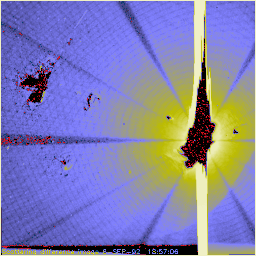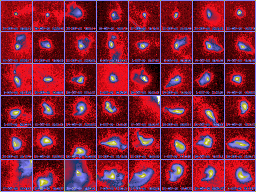
This week sees a small workshop dedicated to that curious-sounding subject, which the instrument scientists call the SXT point response function. But the image below shows that scattering can be spectacular:

This image illustrates numerous systematic effects that a heavy-duty overexposure brings to the foreground. We get such overexposures - roughly a factor of 10,000 too long - when a flare goes off just as Yohkoh is passing through the Van Allen Belts. At these times (luckily for the detector, rare) we get splashy effects. An obvious one is the "bleed" spike running up and down the columns at the flare site (just too many electrons for one pixel to hold). See the earlier nuggets "Cleaning up our Act" and "The CCD Nitty-Gritty Ditty" for more on this subject. Another obvious effect is the six-vaned shadow of the "spider", the mounting that holds the SXT mirrors (both secondary and primary) in a grazing-incidence telescope of this type. Other effects, such as the beautiful almost-concentric rings, are too arcane to go into here, but we think we understand them.
The main point of this image is to show the mirror scattering, which is the golden halo spreading out from the flare. The presence of this scattering has a major impact on how we estimate the coronal temperature from the X-ray images. Thus we are having this week's workshop to study these effects, and this science nugget contains some of the preparatory material.
The easiest way to study the point-response function of a telescope is, well, to find a point source. We don't have the luxury with SXT to observe a star or a quasar, which would do just fine - they are too faint for us. However solar flares come in all sizes and we can search for small ones. Here's an array of the 48 smallest recent flares, sorted roughly in order of compactness:

Amazingly enough, these tiny flares include some major ones. One, an X-class flare of Sep. 30, 2000 has already put in a guest appearance as an SXT science nugget here, because of other interesting properties.

This flare is near the limb, as sketched in, but not beyond it. If worst comes to worst and we cannot analyze flares of this sort properly, our next fall-back position for studying scattering (and the point response function in general) will be to look at flares actually half-occulted by the limb. These happen surprisingly often, and we believe that the limb of the Sun is extremely sharp - much sharper (you figure this one out for homework, please) - than the limb of the Moon. So it's a natural "knife-edge" for optical purposes.
The nice round extension of the deep exposure, to the left of the flare, probably is mostly scattering. The contours show the outline of a properly-exposed image; the colors show an image overexposed by an intentional factor of about 200. The reason this flare is better for us than the "starburst" flare shown at the top of the page is that it (and the whole list of 48) were observed with special exposure sequences to allow us to do the calibrations properly. We just figured out (thanks, Dave) in 1998 how to do that.
None, actually - after the workshop we'll do another science nugget on how it worked out. It is quite a thrill to be able to address difficult technical questions like this some ten years after Yohkoh's launch - and success at answering them will certainly multiply the scientific return from this nice satellite.
January 12, 2001